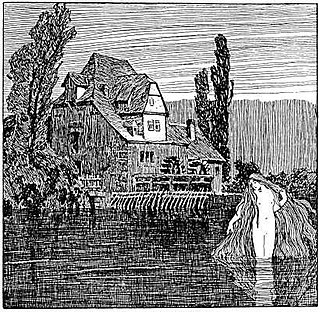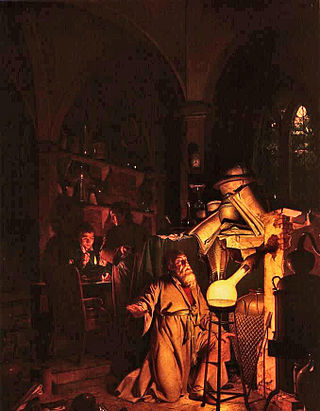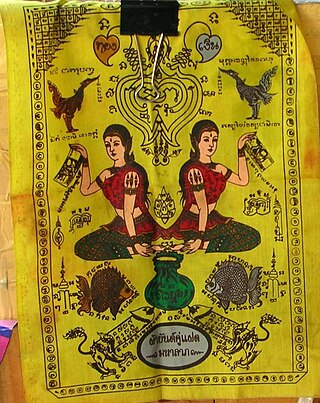Related Research Articles
The serpent, or snake, is one of the oldest and most widespread mythological symbols. The word is derived from Latin serpens, a crawling animal or snake. Snakes have been associated with some of the oldest rituals known to mankind and represent dual expression of good and evil.
The Abenaki people are an indigenous peoples of the Americas located in the Northeastern Woodlands region. Their religious beliefs are part of the Midewiwin tradition, with ceremonies led by medicine keepers, called Medeoulin or Mdawinno.
Finnish mythology is a commonly applied description of the folklore of Finnish paganism, of which a modern revival is practiced by a small percentage of the Finnish people. It has many features shared with Estonian and other Finnic mythologies, but also shares some similarities with neighbouring Baltic, Slavic and, to a lesser extent, Norse mythologies.

Kalevipoeg is a 19th century epic poem by Friedrich Reinhold Kreutzwald which has since been considered the Estonian national epic.

In mythology, folklore and speculative fiction, shape-shifting is the ability to physically transform oneself through an inherently superhuman ability, divine intervention, demonic manipulation, sorcery, spells or having inherited the ability. The idea of shape-shifting is in the oldest forms of totemism and shamanism, as well as the oldest existent literature and epic poems such as the Epic of Gilgamesh and the Iliad. The concept remains a common literary device in modern fantasy, children's literature and popular culture.

In Slavic mythology, vodyanoy or vodyanoi is a water spirit. In Czech and Slovak fairy tales, it is called vodník, and it is considered to be the equivalent creature as the Wassermann or nix of German fairy tales.
Nordic folklore is the folklore of Denmark, Norway, Sweden, Iceland and the Faroe Islands. It has common roots with, and has been mutually influenced by, folklore in England, Germany, the Low Countries, the Baltic countries, Finland and Sapmi. Folklore is a concept encompassing expressive traditions of a particular culture or group. The peoples of Scandinavia are heterogenous, as are the oral genres and material culture that has been common in their lands. However, there are some commonalities across Scandinavian folkloric traditions, among them a common ground in elements from Norse mythology as well as Christian conceptions of the world.
Estonian mythology is a complex of myths belonging to the Estonian folk heritage and literary mythology. Information about the pre-Christian and medieval Estonian mythology is scattered in historical chronicles, travellers' accounts and in ecclesiastical registers. Systematic recordings of Estonian folklore started in the 19th century. Pre-Christian Estonian deities may have included a god known as Jumal or Taevataat in Estonian, corresponding to Jumala in Finnish, and Jumo in Mari.
The Knocker, Knacker, or Tommyknocker (US) is a mythical, subterranean, gnome-like creature in Cornish and Devon folklore. The Welsh counterparts are coblynau. It is closely related to the Irish leprechaun, Kentish kloker and the English and Scottish brownie. The Cornish described the creature as a little person 2 ft 0 in (0.61 m) tall, with a disproportionately large head, long arms, wrinkled skin, and white whiskers. It wears a tiny version of standard miner's garb and commits random mischief, such as stealing miners' unattended tools and food.

Scottish mythology is the collection of myths that have emerged throughout the history of Scotland, sometimes being elaborated upon by successive generations, and at other times being rejected and replaced by other explanatory narratives.
The tradition of folklore—folktales, jokes, legends, and the like—in the Turkish language is very rich, and is incorporated into everyday life and events.
Micronesian mythology comprises the traditional belief systems of the people of Micronesia. There is no single belief system in the islands of Micronesia, as each island region has its own mythological beings.

"The Nixie of the Mill-Pond" is a German fairy tale that tells the story of a man captured by a nix and his wife's efforts to save him. The Brothers Grimm collected the tale in their Grimm's Fairy Tales (1857) as tale number 181. A note in the volume indicated that it was current in Upper Lusatia when the story was collected. Andrew Lang included a version in The Yellow Fairy Book, citing his source Hermann Kletke and titling it The Nixy.

Elements of the supernatural and the fantastic were an element of literature from its beginning, though the idea of a distinct genre, in the modern sense, is less than two centuries old.

Jewish mythology is the body of myths associated with Judaism. Elements of Jewish mythology have had a profound influence on Christian mythology and on Islamic mythology, as well as on abrahamic culture in general. Christian mythology directly inherited many of the narratives from the Jewish people, sharing in common the narratives from the Old Testament. Islamic mythology also shares many of the same stories; for instance, a creation-account spaced out over six periods, the legend of Abraham, the stories of Moses and the Israelites, and many more.

Colombian folklore are beliefs, customs and cultural traditions in Colombia.

West African mythology is the body of myths of the people of West Africa. It consists of tales of various deities, beings, legendary creatures, heroes and folktales from various ethnic groups. Some of these myths traveled across the Atlantic during the period of the Trans-Atlantic slave trade to become part of Caribbean, Cuban and Brazilian mythology.

Thai folklore is a diverse set of mythology and traditional beliefs held by the Thai people. Most Thai folklore has a regional background for it originated in rural Thailand. With the passing of time, and through the influence of the media, large parts of Thai folklore have become interwoven with the wider popular Thai culture.
Moussa Gname is a culture hero in epic and folklore tales of the Songhai people, in West Africa.
References
- ↑ Belcher, African Myths, 21, 459.
- ↑ Knappert, Jan (1967). "The Epic in Africa". Journal of the Folklore Institute . 4 (2/3): 171–90. doi:10.2307/3813996. JSTOR 3813996.